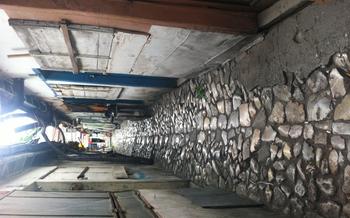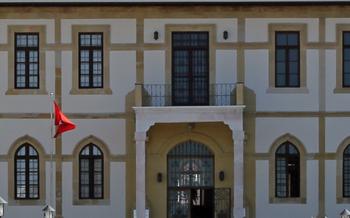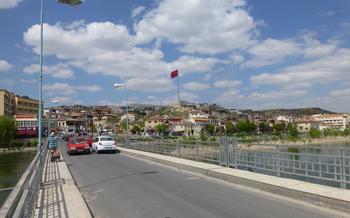
Osmancık Bridge historic bridge over the Kızılırmak River
- Unveiling the Osmancık Bridge: A Historic Masterpiece
- An Enchanting Setting: The Kızılırmak River Valley
- A Journey Through Time: Exploring the Bridge's History
- A Culinary Adventure: Savoring Local Delights
- A Photographer's Paradise: Capturing the Beauty
- A Haven for Nature Lovers: Exploring the Surroundings
- A Cultural Immersion: Experiencing Local Traditions
- A Pilgrimage Site: The Tomb of Hacı Bektaş Veli
- A Glimpse into History: The Hitit Museum
- An Architectural Gem: The Great Mosque of Çorum
- A Thrilling Adventure: White-Water Rafting on the Kızılırmak River
- A Relaxing Escape: The Thermal Springs of Ilıca
- Insider Tip: Discovering Hidden Gems Off the Beaten Path
Unveiling the Osmancık Bridge: A Historic Masterpiece
Spanning the majestic Kızılırmak River, the Osmancık Bridge stands as a testament to the rich history and architectural prowess of Çorum. Built in the 16th century during the Ottoman era, this iconic bridge has played a pivotal role in connecting the regions and facilitating trade and transportation. Its strategic location on the ancient Silk Road made it a crucial hub for travelers and merchants, fostering cultural exchange and economic growth. The bridge's remarkable resilience and enduring strength have earned it a place among Turkey's most treasured historical landmarks, drawing visitors from far and wide who seek to marvel at its architectural beauty and delve into its captivating stories.
Historical Significance: The Osmancık Bridge is a testament to the engineering prowess of the Ottoman Empire, showcasing their mastery in bridge construction. It was commissioned by the Ottoman Sultan Suleiman the Magnificent, who sought to improve the infrastructure of the region and facilitate trade between Anatolia and the Middle East. The bridge's strategic location on the Kızılırmak River, a major waterway, made it a crucial transportation link, contributing to the economic prosperity of the region.
Architectural Features: The Osmancık Bridge is a remarkable example of Ottoman architecture, showcasing a blend of functionality and aesthetics. Constructed using massive stone blocks, the bridge features seven arches that gracefully span the river, creating a harmonious balance between strength and elegance. The bridge's sturdy piers, designed to withstand the powerful currents of the Kızılırmak River, are a testament to the engineering expertise of the Ottoman builders.
Role in the Development of the Region: The Osmancık Bridge played a pivotal role in the development of the Çorum region, serving as a vital link between the eastern and western parts of the province. It facilitated the transportation of goods and people, contributing to the economic growth and prosperity of the region. The bridge's strategic location on the trade routes also fostered cultural exchange and interaction between different regions, leading to a rich tapestry of customs and traditions in Çorum.
Legends and Folklore: Over the centuries, the Osmancık Bridge has become entwined with local legends and folklore, adding to its mystique and allure. One popular legend tells the tale of a young woman who, in a desperate attempt to escape an arranged marriage, threw herself into the river from the bridge. Her spirit is said to haunt the bridge, appearing to travelers on misty nights, forever searching for her lost love. These tales have woven the bridge into the cultural fabric of the region, making it a source of fascination and wonder for locals and visitors alike.
An Enchanting Setting: The Kızılırmak River Valley
The Osmancık Bridge stands majestically amidst the breathtaking beauty of the Kızılırmak River Valley. The river, with its meandering course and crystal-clear waters, creates a picturesque landscape that is a feast for the eyes. The valley is a haven for nature enthusiasts, offering a rich tapestry of flora and fauna. The lush vegetation, including vibrant wildflowers, carpets the hillsides, while the air is filled with the melodious chirping of birds. The geological formations and rock formations along the riverbank add a touch of drama to the scenery. The panoramic views from the bridge are simply stunning, offering a bird's-eye perspective of the river valley and the surrounding mountains. It is a sight that leaves visitors in awe, making the Osmancık Bridge not just a historical landmark but also a gateway to the natural wonders of the Kızılırmak River Valley.
A Journey Through Time: Exploring the Bridge's History
The Osmancık Bridge has stood as a silent witness to the passage of time, its stones carrying the weight of history. Its construction, dating back to the 14th century, was a testament to the ingenuity and engineering prowess of the Seljuk Turks. The bridge played a pivotal role in facilitating trade and transportation between the regions of Anatolia, as it spanned the mighty Kızılırmak River, a natural barrier that often hindered movement. Over the centuries, the bridge has endured various trials and tribulations, including floods, earthquakes, and wars. However, it has always emerged resilient, thanks to the unwavering efforts of the local communities who recognized its importance and undertook restoration and preservation projects to ensure its longevity. Today, the bridge stands as a symbol of resilience, a testament to the enduring spirit of the people who have called this region home throughout the ages. Its historical significance has been recognized, and it has been designated as a protected cultural heritage site, ensuring its preservation for generations to come.
A Culinary Adventure: Savoring Local Delights
Çorum's cuisine is a delightful blend of traditional Turkish flavors and regional specialties. The city is renowned for its unique dishes that showcase the freshest local ingredients. One must-try delicacy is Çorum köftesi, a delectable dish of grilled meatballs made with a special blend of spices and herbs. These succulent meatballs are often served with a refreshing yogurt sauce and grilled vegetables, creating a harmonious balance of flavors.
For a taste of authentic Turkish cuisine, venture into the local markets and bazaars, where vendors display an array of colorful spices, dried fruits, and freshly baked goods. Here, you can indulge in traditional Turkish sweets such as lokum, a soft and chewy delight made with sugar, starch, and flavored with rose water or pistachio. Çorum is also famous for its flavorful keşkek, a hearty dish made from pounded wheat, meat, and spices, slow-cooked to perfection.
Indulge in the art of Turkish coffee and tea brewing, an integral part of the local culture. Sip on a frothy cup of Turkish coffee, prepared using finely ground coffee beans and served in small cups. For a refreshing alternative, try Turkish tea, a light and flavorful brew served in tulip-shaped glasses. These beverages are often accompanied by traditional Turkish delights, such as baklava or Turkish delight, creating a sweet and satisfying experience.
A Photographer's Paradise: Capturing the Beauty
The Osmancık Bridge is a photographer's paradise, offering a plethora of stunning photo opportunities. The changing colors of the Kızılırmak River and the sky create a vibrant backdrop for capturing picturesque landscapes and panoramic views. The bridge itself, with its intricate architecture and imposing presence, provides a striking subject for photography enthusiasts.
The best time to capture the beauty of the bridge is during sunrise and sunset, when the warm hues of the sky bathe the structure in a golden glow. The bridge's reflection in the still waters of the river creates a mesmerizing effect that is perfect for capturing long-exposure shots.
For those interested in capturing the bridge's grandeur, a wide-angle lens is recommended to capture the sweeping views of the structure and its surroundings. A telephoto lens, on the other hand, can be used to isolate specific architectural details and create dramatic close-up shots.
Patience and experimentation are key to capturing the perfect shot. Take the time to explore different angles and perspectives, and don't be afraid to experiment with different shutter speeds and apertures to achieve the desired effect. Whether you're a professional photographer or simply an enthusiast, the Osmancık Bridge promises to provide you with unforgettable photo opportunities.
A Haven for Nature Lovers: Exploring the Surroundings
Beyond the bridge, nature enthusiasts are rewarded with a wealth of captivating natural attractions and activities. The surrounding region boasts a tapestry of landscapes, from rolling hills and lush forests to serene lakes and hidden waterfalls. Nature lovers can embark on a journey through these unspoiled wildernesses, immersing themselves in the tranquility and grandeur of the natural world.
The area surrounding the Osmancık Bridge is a haven for hikers and trekkers, with a network of well-marked trails that meander through forests, valleys, and along the riverbanks. These trails offer varying degrees of difficulty, catering to hikers of all levels, from leisurely strolls to challenging climbs. The rich flora and fauna of the region will delight nature enthusiasts, with the opportunity to spot a variety of bird species, butterflies, and small mammals.
For those seeking a more thrilling experience, the Kızılırmak River offers the perfect setting for white-water rafting. With its cascading waterfalls and swirling currents, the river presents an adrenaline-pumping adventure for rafters of all skill levels. Participants can navigate the river's rapids, surrounded by stunning scenery and the invigorating spray of the water.
Whether you prefer a leisurely walk through the woods, a challenging trek up a mountain, or an exhilarating rafting experience, the surroundings of the Osmancık Bridge offer a variety of opportunities to connect with nature and create lasting memories.
A Cultural Immersion: Experiencing Local Traditions
Çorum is a treasure trove of cultural experiences that offer a glimpse into the rich heritage and traditions of the region. The vibrant festivals and celebrations that take place throughout the year are a testament to the cultural diversity of the province. One of the most notable events is the annual Hıdırellez festival, which is celebrated on May 6th and marks the arrival of spring. The festival is characterized by colorful parades, traditional music and dance performances, and picnics in the countryside.
The local music, dance, and folklore performances are a reflection of the rich cultural heritage of the region. Visitors can enjoy traditional Turkish music, such as bağlama and darbukas, and witness the graceful movements of folk dances like halay and zeybek. These performances often take place in local cultural centers, village squares, or during special events.
Çorum is also renowned for its traditional handicrafts and souvenirs. Visitors can find a variety of handmade items, such as carpets, pottery, jewelry, and wood carvings, in the local markets and bazaars. These items are often made using traditional techniques and showcase the skill and artistry of the local craftsmen.
Interacting with the local people is an essential part of experiencing the culture of Çorum. The people of Çorum are known for their warm hospitality and are always willing to share their stories and traditions with visitors. Whether it's chatting with a local shopkeeper, joining a village gathering, or simply exchanging greetings on the street, visitors will find that the people of Çorum are welcoming and friendly.
A Pilgrimage Site: The Tomb of Hacı Bektaş Veli
The Tomb of Hacı Bektaş Veli is a revered pilgrimage site for followers of the Alevi branch of Islam. Hacı Bektaş Veli, a prominent Sufi saint and philosopher, founded the Alevi order in the 13th century. His tomb, located in the village of Hacıbektaş, attracts thousands of pilgrims from Turkey and beyond.
The tomb complex includes a mosque, a dervish lodge, and a museum dedicated to Hacı Bektaş Veli's life and teachings. Visitors can explore the serene courtyards, admire the intricate tilework and calligraphy, and learn about the rich history of the Alevi tradition.
The annual Hacı Bektaş Veli Commemoration, held in August, is a major event that draws large crowds of pilgrims. During the commemoration, visitors participate in religious ceremonies, engage in traditional dances and rituals, and pay their respects at the tomb of Hacı Bektaş Veli.
Visiting the Tomb of Hacı Bektaş Veli offers a unique opportunity to immerse oneself in the spiritual traditions and cultural heritage of the Alevi community. The site exudes an atmosphere of peace and tranquility, making it an ideal destination for those seeking a meaningful pilgrimage experience.
A Glimpse into History: The Hitit Museum
The Hitit Museum, a treasure trove of Anatolian history, beckons visitors to delve into the captivating world of the Hittites. This renowned museum houses a remarkable collection of artifacts, shedding light on the rich cultural heritage of this ancient civilization. As you step inside, you'll be transported back in time, discovering the stories of a people who left an indelible mark on the region's history.
The Hittites, who reigned supreme in Anatolia from the 17th to the 13th century BC, were known for their advanced civilization, sophisticated writing system, and impressive architectural achievements. The exhibits at the Hitit Museum showcase their artistry, technological prowess, and religious beliefs.
Among the highlights of the collection is a awe-inspiring collection of stone sculptures and reliefs, depicting deities, rulers, and mythical creatures. These intricate carvings offer a glimpse into the Hittite pantheon and their rich mythology. The museum also houses an impressive array of jewelry, ceramics, weapons, and tools, providing insights into the daily lives of the Hittites.
Interactive exhibits and educational displays make the museum a perfect place to learn about Hittite history and culture. You'll discover their unique writing system, known as cuneiform, and explore the fascinating stories behind their conquests and interactions with neighboring civilizations.
A visit to the Hitit Museum is a journey through time, offering a glimpse into the remarkable achievements of the Hittites. Immerse yourself in the history of this ancient civilization and gain a deeper understanding of their lasting legacy in Anatolia.
An Architectural Gem: The Great Mosque of Çorum
In the heart of Çorum, a city steeped in history and cultural heritage, stands the Great Mosque, a testament to the architectural prowess and religious devotion of the region. Built in the 13th century, this awe-inspiring structure has withstood the test of time, bearing witness to the rise and fall of empires and the ebb and flow of civilizations.
The mosque's intricate tilework, a symphony of vibrant colors and geometric patterns, captivates the eye, drawing visitors into a realm of artistic wonder. Verses from the Quran, inscribed in elegant calligraphy, adorn the walls, adding a layer of spiritual significance to the already sacred space.
Within the mosque's serene interior, a sense of tranquility envelops the soul. The soft light filtering through the stained-glass windows casts an ethereal glow, illuminating the vast prayer hall. The air is filled with the gentle murmur of prayers and the faint scent of incense, creating an atmosphere conducive to contemplation and spiritual connection.
The Great Mosque of Çorum is not merely a place of worship; it is a living testament to the rich cultural heritage of the region. Its architectural grandeur and historical significance make it a must-visit destination for anyone seeking to delve into the heart of Çorum's past.
A Thrilling Adventure: White-Water Rafting on the Kızılırmak River
The Kızılırmak River, with its cascading rapids and swirling currents, offers an exhilarating white-water rafting experience for adventure enthusiasts. Navigate the challenging waters, maneuvering through narrow gorges and steep drops, while surrounded by breathtaking scenery. Experience the thrill of the rapids and the camaraderie of teamwork as you conquer the river's challenges. Along the way, marvel at the stunning landscapes, with lush vegetation and towering cliffs providing a picturesque backdrop to your thrilling adventure.
A Relaxing Escape: The Thermal Springs of Ilıca
Nestled amidst the tranquil landscapes of Çorum, the thermal springs of Ilıca offer a rejuvenating experience for weary travelers. These natural wonders, blessed with therapeutic waters, have been renowned for centuries for their healing properties. Bathe in the warm, mineral-rich pools and let the soothing waters ease away your aches and worries. Choose from various thermal pools and spas, each offering a unique ambiance and facilities. Indulge in a massage or spa treatment to enhance your relaxation. Surrender to the tranquil atmosphere and let the natural surroundings soothe your senses. Emerge from your thermal retreat feeling refreshed, revitalized, and ready to embrace the adventures that await you in Çorum.
Insider Tip: Discovering Hidden Gems Off the Beaten Path
Venture beyond the popular tourist spots and discover the hidden gems that Çorum has to offer. Explore the charming villages nestled in the countryside, each with its own unique character and traditions. Engage with the friendly locals, who are always eager to share their stories and insights into the region's culture. Stumble upon unexpected surprises, such as ancient ruins, hidden waterfalls, or traditional crafts workshops. Create unique and memorable travel memories by exploring the lesser-known treasures of Çorum.









